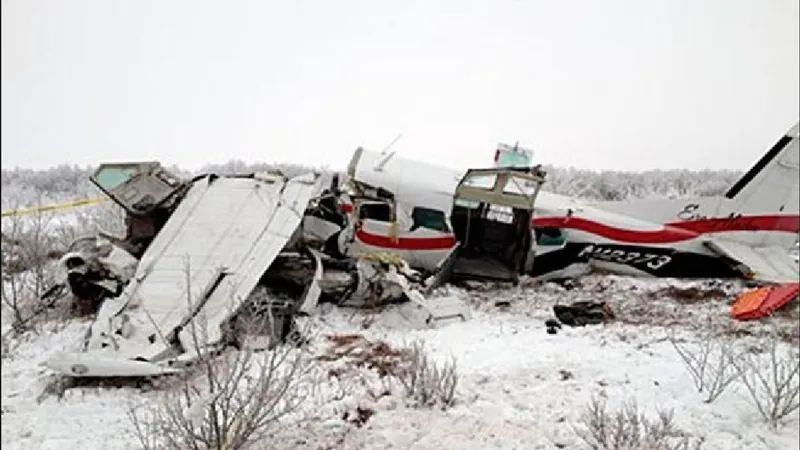On February 4, 2025, tragedy struck Alaska’s essential air travel network when a commuter flight crashed on the unforgiving sea ice, claiming the lives of all ten individuals on board. This devastating incident highlights the critical role of small aircraft in connecting remote communities across the vast and rugged Alaskan landscape, where traditional transportation options are often limited. From medical appointments to educational outreach, these flights serve as lifelines for residents, making the loss all the more profound. As investigations begin into the crash’s cause, the story of those lost reveals the deeply interconnected fabric of Alaskan life, underscoring the importance of aviation safety in one of America’s most challenging environments.
| Attribute | Details |
|---|---|
| Incident | Commuter flight crash in Alaska, Feb 2025, killing all 10 aboard. |
| Flight Purpose | Essential for medical appointments, work meetings, and supply runs. |
| Location of Crash | Norton Sound, southwest of Nome, Alaska. |
| Aircraft | Bering Air single-engine turboprop. |
| Distance Traveled | Flight from Unalakleet to Nome, approximately 150 miles (240 km). |
| Victims | 10 individuals, including a teacher and workers servicing a water treatment plant. |
| Airline’s Service | Bering Air serves 32 villages in western Alaska. |
| Community Impact | Flying is vital for connecting isolated communities to the outside world. |
| Weather Conditions | Alaska’s terrain and rapid weather changes make flying challenging. |
| Federal Response | Officials emphasize the need for improved aviation safety and weather information. |
| Community Support | Residents showed support for Bering Air after the tragedy. |
The Importance of Air Travel in Alaska
In Alaska, flying is not just a luxury—it’s a necessity for many people. With vast stretches of wilderness and limited roads, airplanes serve as crucial links connecting isolated communities to essential services. From medical appointments to work meetings, the commuter flights help residents access what they need to live their daily lives. Without these flights, many Alaskans would struggle to get to the doctor or shop for groceries.
The air travel system in Alaska allows people to travel hundreds of miles quickly. For instance, a flight from Unalakleet to Nome covers about 150 miles, making it a vital route for residents. The ability to fly helps ensure that Alaskans can maintain their jobs, attend school, and receive medical care without the long and often impossible journeys on the ground.
The Recent Tragedy: A Community in Mourning
The recent crash of a commuter flight in Alaska has left the community grieving. With ten lives lost, the tragedy has deeply affected the families and friends of those aboard. Many of the victims were on their way to important commitments, such as medical appointments and educational mentoring. Their loss is felt not only by loved ones but also by the entire community that relied on their contributions.
In the aftermath of the crash, many people have come together to support the families affected. The local schools and organizations have shared memories and stories of the victims, celebrating their lives and the impact they had on others. Gatherings have been held to honor their memory, showing that while the community is in sorrow, they stand united in love and support.
Challenges of Flying in Alaska’s Unique Environment
Flying in Alaska presents unique challenges due to the state’s rugged terrain and rapidly changing weather. From towering mountains to vast tundras, pilots must navigate an ever-shifting landscape. Microclimates can create situations where conditions at one airport differ significantly just a few miles away, making it essential for pilots to stay informed about the weather.
Despite these challenges, improvements in aviation safety and technology have helped reduce accident rates in Alaska. Federal officials are committed to enhancing infrastructure and weather observation systems to ensure safer flights. By addressing these issues, the goal is to create a more reliable air travel network that Alaskans can depend on.
Bering Air: A Lifeline for Remote Communities
Bering Air plays a vital role in connecting remote Alaskan communities to the outside world. Serving 32 villages, the airline provides essential flights that help residents access medical care, education, and supplies. With scheduled flights multiple times a week, Bering Air ensures that even the most isolated areas have a way to reach larger towns and cities.
The community’s support for Bering Air has been heartwarming, especially after the recent tragedy. Residents have expressed their gratitude and affection for the airline, showing that they value the service it provides. Events honoring the airline and its pilots have taken place, demonstrating the strong bond between Bering Air and the communities it serves.
Safety Measures and Future Improvements
In light of the recent crash, federal officials are focusing on improving aviation safety measures throughout Alaska. This includes addressing runway maintenance issues, upgrading weather observation systems, and enhancing telecommunications. By ensuring that pilots have access to the best information and equipment, the goal is to reduce the risk of accidents and enhance passenger safety.
Transportation Secretary Sean Duffy has pledged to work with local officials to develop a comprehensive plan for future improvements. This collaboration aims to create a safer flying environment while maintaining the essential air travel services that so many Alaskans rely on. Community input will play a significant role in guiding these safety initiatives.
The Role of Community in Healing
After the devastating crash, the community has rallied together to support one another in the healing process. Local organizations and schools have organized memorial events, allowing people to share their grief and stories. This sense of unity helps individuals cope with their loss and shows the strength of the community during difficult times.
Acts of kindness have also emerged, with neighbors helping each other as they navigate their grief. Whether through simple gestures or larger support initiatives, the community is demonstrating that together they can overcome tragedy. This solidarity is a reminder of the importance of connection and support in times of sorrow.
Frequently Asked Questions
What was the cause of the recent plane crash in Alaska?
The cause of the crash is still under investigation. It involved a commuter flight that tragically killed all 10 passengers on board.
Why is flying essential for Alaskans?
Flying is crucial in Alaska due to its vast geography. Many communities are isolated, and air travel connects residents to medical care, work, and essential supplies.
How does Alaska’s weather affect flying?
Alaska’s weather can change rapidly, creating challenges for flying. Microclimates mean conditions can vary significantly even within short distances.
What improvements are being made for aviation safety in Alaska?
Federal officials are working to enhance aviation safety by addressing infrastructure issues like runway lights and improving weather observation systems.
Who were some of the victims on the crashed flight?
The victims included individuals traveling for medical appointments, community service, and educational mentoring, highlighting the flight’s importance to daily life.
How does Bering Air support remote communities in Alaska?
Bering Air operates flights to 32 villages in western Alaska, providing essential transport for residents to access services and supplies.
What community support has Bering Air received after the crash?
Following the crash, communities expressed their love and support for Bering Air, with residents greeting pilots and showing solidarity despite their grief.
Summary
A tragic plane crash in Alaska last week claimed the lives of all 10 passengers on board. The commuter flight was part of Alaska’s crucial air travel system, connecting remote communities for essential services like medical appointments and work meetings. Among the victims were a retired teacher and two men traveling for maintenance work at a water treatment facility. Officials stress the importance of improving aviation safety in Alaska’s challenging weather and terrain. The local airline, Bering Air, serves 32 villages and has received heartfelt support from residents who rely on its services. This incident highlights the vital role of air travel in Alaska’s daily life.



